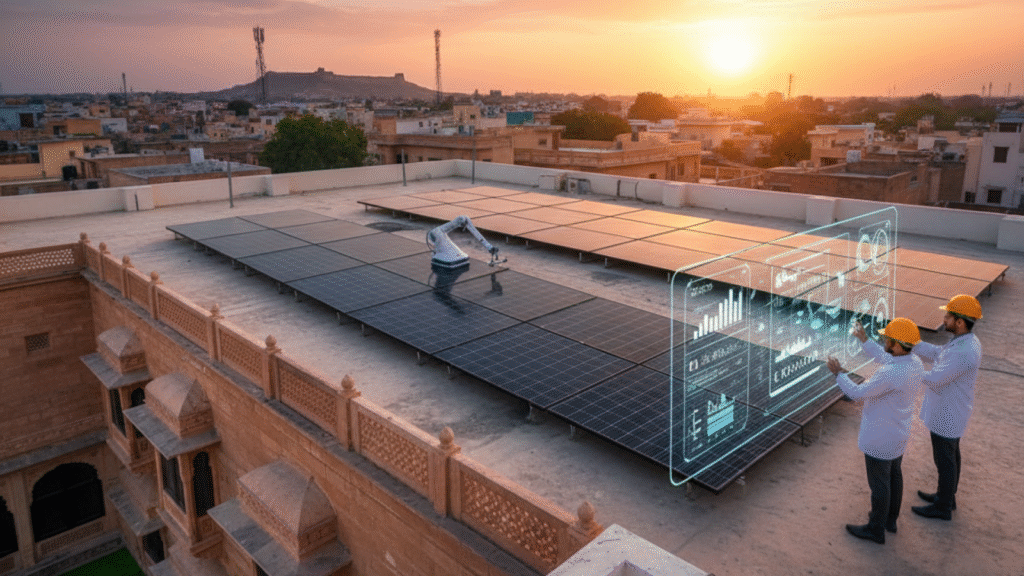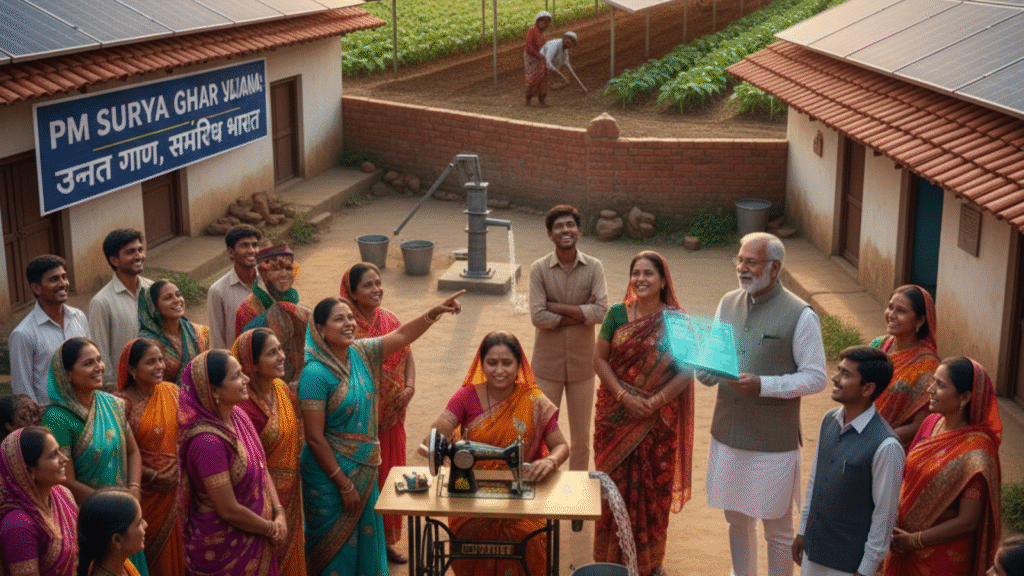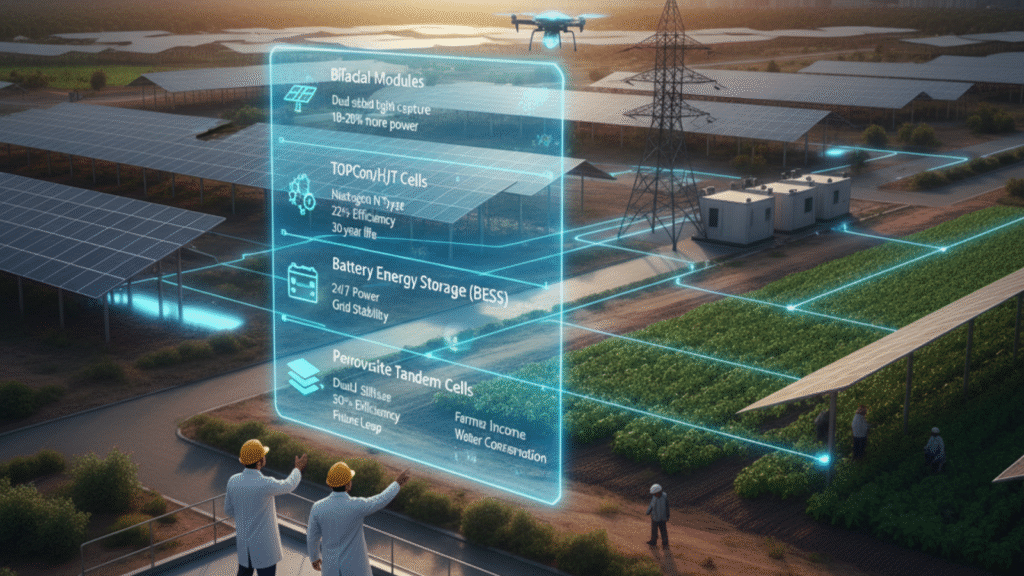
India stands at the cusp of a complete energy overhaul, making the phrase “Solar Revolution in India” more than just a buzzword—it’s a massive national reality. As the nation races toward its target of 500 GW of non-fossil fuel capacity by 2030, the solar sector is evolving at a breakneck pace. Consequently, the future is defined not just by capacity, but by technological breakthroughs and intelligent integration.
This article explores the cutting-edge trends and innovations that will accelerate the Solar Revolution in India and power its energy landscape into the next decade.
Driving the Solar Revolution: Ultra-High Efficiency Technologies

The focus is rapidly moving away from standard panels to new-generation PV (Photovoltaic) technologies that squeeze maximum power from every ray of sunlight.
The Dominance of n-Type and Bifacial Modules in India
India’s energy sector now demands higher efficiency. N-Type Cells (e.g., TOPCon and HJT) are a prime example. These advanced cell structures offer significantly higher efficiency (22%+) and deliver superior performance, especially in low-light conditions, compared to older P-type technology. Moreover, they exhibit minimal degradation over time, promising a 30-year operational life. Similarly, Bifacial Technology captures sunlight from both the front and the back side. As a result, in utility-scale projects, this design can boost energy generation by 10-20%, drastically lowering the overall cost of energy. Therefore, manufacturers actively choose these technologies.
The Perovskite Promise: The Next Leap in India’s Solar Power
Perovskite is the most talked-about solar material globally. Intrinsically, it is cheap, highly efficient, and can be printed on thin, flexible surfaces. While R&D is currently underway in India, commercial deployment of tandem cells (which combine silicon with a perovskite layer) is expected by the late 2020s. Ultimately, this innovation could push solar panel efficiency past 30%, representing a true technological leap for the Solar Revolution in India.
Solving Intermittency: Storage and Smart Grid for the Revolution

Solar power’s main limitation is its intermittency (no generation at night or on cloudy days). Consequently, the future success of solar is entirely dependent on effective energy storage and intelligent grid management.
The Rise of Battery Energy Storage Systems (BESS) in the Solar Revolution
Battery Energy Storage Systems are no longer a luxury—they are a necessity for grid stability. Utility-scale and commercial BESS projects are actively integrated with solar farms to store excess midday power and discharge it during peak evening demand. Furthermore, the national trend is toward Solar-Wind-BESS hybrid projects, which provide a stable, round-the-clock power supply.
Smart Grids and AI: Optimizing India’s Solar Energy Flow
The sheer scale of India’s solar capacity requires an intelligent grid infrastructure. Therefore, Artificial Intelligence (AI) and the Internet of Things (IoT) are being deployed for several key functions. For instance, AI algorithms monitor panel and inverter health for predictive maintenance, preventing system failures. In addition, AI uses sophisticated weather data to accurately forecast generation and grid load, enabling utilities to manage power flow more efficiently.
Policy, Decentralization, and the Socio-Economic Impact

The future of power generation is decentralized, moving closer to the consumption point. This grassroots movement is driving the Solar Revolution in India from the ground up.
PM Surya Ghar Yojana: Decentralizing the Solar Revolution in India
The PM Surya Ghar Muft Bijli Yojana is the most significant government push for distributed solar, targeting one crore (10 million) households. This ambitious scheme fundamentally changes India’s energy mix, shifting millions of citizens from being pure energy consumers to prosumers (producers and consumers). This massive adoption also drives down the costs of installation and maintenance services nationwide.
Sustainable Land Use: Agrivoltaics and Floating Solar
To conserve India’s valuable land resources, solar energy is moving to underutilized spaces. Agrivoltaics integrates agriculture and solar panels on the same land, increasing farmer income and resource efficiency. Similarly, Floating Solar projects, installed on reservoirs and water bodies, save land and improve panel efficiency due to the natural cooling effect of the water, contributing significantly to the Solar Revolution in India.
Key Technological Trends Driving India’s Solar Future (Table)

| Technology/Trend | Primary Function | Impact on the Solar Revolution in India | Status |
| Bifacial Modules | Captures light from both sides of the panel. | Increases energy generation by up to 20% in large parks. | High Commercial Adoption |
| TOPCon/HJT Cells | Advanced n-Type cell structure. | Drives panel efficiency past 22%; ensures longer panel life. | Rapidly Growing Manufacturing |
| Battery Energy Storage (BESS) | Stores solar energy for non-sunny hours. | Solves the intermittency problem; ensures 24/7 power availability. | High Investment Phase |
| Perovskite Tandem Cells | Next-generation material that can boost efficiency over 30%. | Potential to drastically lower the long-term cost of solar power. | Active R&D/Pilot Projects |
| Agrivoltaics | Dual-use of land for solar generation and crop cultivation. | Conserves land and increases farmer income and resource efficiency. | Nascent, Emerging Trend |
Frequently Asked Questions (FAQ) about the Solar Revolution in India
Q1. What key factors are driving the “Solar Revolution in India”?
A. The Solar Revolution in India is primarily driven by three main factors: aggressive government targets (like the 500 GW non-fossil fuel capacity goal), falling technology costs, and strong policy support (such as the PM Surya Ghar Yojana and PLI schemes) which incentivize both large-scale power plants and decentralized rooftop adoption.
Q2. How will India manage the grid stability with the massive increase in solar power?
A. Grid stability will be effectively managed through the deployment of large-scale Battery Energy Storage Systems (BESS) and the creation of Solar-Wind Hybrid projects for consistent power supply. Crucially, AI/IoT-enabled Smart Grids are implemented to predict and manage real-time fluctuations in solar energy supply and demand.
Q3. What is the next major technological breakthrough expected after traditional silicon solar panels?
A. The next major technology expected to succeed or augment traditional silicon is Perovskite. This is a low-cost, high-efficiency material. When layered on top of silicon (creating tandem cells), it is capable of achieving efficiencies above 30%, representing a transformative leap for solar generation in India.
Q4. What is India doing to reduce its dependence on imported solar components?
A. India is actively promoting vertical integration and domestic manufacturing through the Production Linked Incentive (PLI) scheme. This crucial policy aims to build the entire solar supply chain locally—from raw materials like polysilicon and wafers to advanced cells and modules—securing the nation’s energy independence.
Q5. What is the PM Surya Ghar Yojana’s role?
A. It’s crucial for decentralized power, turning millions of households into energy producers, easing grid load, and reducing electricity bills.

